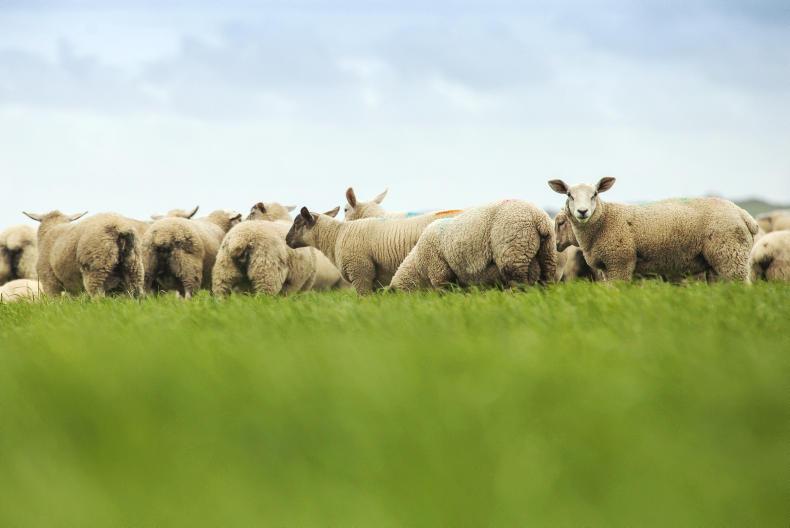The last few weeks leading up to weaning and the immediate post-weaning period are vital in maintaining high levels of lamb performance.
The contribution of ewe milk yield to lamb performance declines greatly in late weaning and daily liveweight gain is underpinned by the quality of grass on offer (and concentrates in systems where lambs are being creep-fed).
The year-to-date has largely been good for grassland management. Utilisation in March and April was significantly improved on recent years.
Differences have emerged in recent weeks, however, depending on numerous factors including the farm’s stocking rate and grass growth rates, which have been influenced recently by the volume of fertiliser applied and rainfall levels throughout May.
Heavy rainfall in the last week is also starting to have a growing influence. Delayed silage cutting is capable of having a knock-on effect on grass supply and in particular to limit the chances of having highly digestible herbage coming into the rotation in late lactation or post-weaning. All of these factors will hit performance hard if grazing plans are not tweaked.
Post-grazing heights
Post-grazing heights are another area where targets may need to be looked at. Teagasc research lists post-grazing heights ranging from 4cm to 5cm in May, rising to 5.5cm to 6cm in June and 6cm in July. This is for a rotational grazing system with equivalent targets of 6cm, 6cm to 7cm and 7cm to 8cm respectively in a set-stocking scenario.
The feasibility of sticking to these targets will depend on previous management and ultimately the quality of the sward and stem-to-leaf ratio.
Many farms which experienced higher than normal growth this spring or had later-lambing flocks which struggled to get back on track after supplies ran ahead of demand may be in this situation. Sticking to post-grazing heights in such circumstances and forcing lambs to graze swards with a high proportion of stem will hit performance hard.
Ewes and lambs should be moved to fresh grazing where possible with topping carried out where ewes or dry stock are not in a position to graze down swards.
Topping should be based on more than aesthetics – the sward should be mowed down to 3.5cm to 4cm as topping swards to a height of 5cm to 6cm is wasted time that has come at considerable cost.
Post-weaning supply
Mid-season March lambing flocks should now also be priming themselves for weaning. A flock with a mean lambing date of 10 March will reach 14 weeks post-lactation on 16 June. Some farms opt to delay weaning beyond a 14-week lactation period where lambs are grazing ahead of ewes and it is not leading to ewes competing with lambs for high-quality grass. In the absence of such a reason, there is little justification for delaying weaning.
Grass supplies are also reported as tightening on some farms over the last two weeks. This has stemmed in cases from a dip in temperatures, while on heavier soils heavy rainfall has not helped. A contributor in other cases is farmers being in a good position with grass supplies and skipping fertiliser application. Swards which are depleted on nutrients will take longer to recover.
Fertiliser also has a role in maintaining sward quality for longer in June and July. The plant will be under less pressure when it is actively growing, which will reduce the rate of a seed head establishing. It does not take huge volumes with even a small allocation of 10 to 15 units nitrogen helping to maintain quality.
Where highly stocked farms are coming under pressure for grass supplies, it is vital that opportunities to get fertiliser applied are not missed. The recommended application rate is 20 to 30 units depending on grass supply and demand.
Targeting soils with a known soil deficiency and replenishing lost nutrients after silage has been harvested is also central to reducing recovery times and enhancing quality.
Nutrient-deficient soils
The recommended P and K application rates for soils with varying indexes and stocked at 130kg to 170kg organic nitrogen per hectare, or 10 to 13 ewes per hectare, is detailed in Table 1. The table also includes an example fertiliser programme, with Teagasc advising farmers to switch from CAN to protected urea.
Targeting compound fertilisers on swards early in the season will help boost growth rates over the entire season. For soils low in K, some farmers prefer to delay applying significant volumes early in the year due to grass tetany concerns.
Late July or August is a good time to target soils with a high K compound fertiliser or muriate of potash (50% K). Access to cattle slurry will aid in increasing K levels faster.
For swards at index 3 for fertility, maintenance fertiliser levels in grazing areas are relatively low. Advice previously published by Mark Plunkett of Teagasc highlights the most suitable fertiliser for sheep farms that are not cutting excessive silage/hay crops is 18-6-12 or 10-10-20 depending on soil P and K levels. This is followed by 24s or 27s or straight N depending on grass demand throughout the growing season. These rates can be reduced if soils are receiving organic manures (values shown in Table 2).
Weaning procedure
The two types of weaning practised on farms are gradual and abrupt weaning. Farmers find merits in both systems. Abrupt weaning, whereby all lambs are separated from ewes in one go, can lead to higher stress levels at first but lambs generally settle quickly.
Disruption is minimised where lambs have access to high-quality leafy swards which as detailed above also limits any setback in performance. It is important to note that good fencing is required with lambs taking longer to settle.
Gradual weaning where a number of ewes are removed from the flock in stages tends to reduce stress with fewer lambs unsettled.
The downside here is where ewes and lambs are grazing poor-quality swards with performance in weaned lambs hit.






 This is a subscriber-only article
This is a subscriber-only article











SHARING OPTIONS: